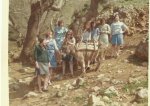GREECE TRIP APRIL 1966 - PART 3 - OLYMPIC FUN & GAMES & MYCENAE


By Linda Wigzell Cress
- 2070 reads
Monday 11TH April was the official start of our coach tour of the Peloponnesos, the southern peninsular of Greece with many ancient sites, Corinth being possibly the most famous. An ancient city state between Athens and Sparta, the ruins were amazingly well preserved. We marvelled at rows of streets with malls of ancient shops, and an impressive agora overlooked by the great Temple of Apollo with its sacred pool. I was later to regret leaving my suntan lotion somewhere among the ruins!
A highlight of this part of the itinerary was a voyage through the Corinthian Canal, which separates mainland Greece from the Peloponnesos. I must admit to not being very keen on the idea of this, as I couldn’t (and still can’t) swim and dislike anything boaty; however, I am glad I didn’t miss this excursion; it was awe-inspiring; the large ship cutting a very tight course through the turquoise blue water, with the high walls rearing up on each side seeming to come close enough to touch. However, I kept my hands to myself and my eyes closed for quite a bit of the experience.
The time came only too soon to get back on the coach to travel to Olympia – yes, THAT Olympia, Mother of the Olympic games no less. There we settled in for 2 nights at a Youth Hostel situated at 18 Kondily Fraxitelous Street, Olympia.
We spent the first day exploring the town and shopping for baskets and trinkets, with one shopkeeper insisting on instructing me and Jill in the fine art of Zorba’s Dance – again! We were experts by the time we got home! I bought a sheepskin rug there which lasted at least 60 years. We were also wise enough to purchase sunhats in preparation for the stay on the island of Mykonos later in the month.
The next day, 12th April, was all about exploring the ancient ruins of Olympia. These include the Temple of Hera, Queen of the Greek deities. We were told this temple was originally jointly dedicated to Hera and Zeus (until a new one was built for him elsewhere) and is the oldest most venerated temple in Greece. The Olympic flame is lit at the altar of this temple before being carried round the world and eventually lighting the ceremonial flame to signify the start of the Games at whichever venue has the honour to be the host that year.
Not to be outdone, and having two P.E. teachers amongst our number, one of the Susans (I think it was the very droll Sue Reid), lacking an actual Olympic Torch, ceremoniously ‘lit’ a baguette at the altar and ran round the stadium holding it aloft, followed by said P.E. teachers who (obviously) raced round the track. This was getting to be a habit! Bets were not laid as to the winner but they both made it back.
We then continued our explorations at the Olympia Museum, which amongst many other antiquities and works of art boasted a very obviously masculine statue by Praxitelese of Hermes holding the baby Dionysus. Sport, History, Art and sex education all in one day. Can’t go wrong!
After a picnic lunch we decided to do a bit of sunbathing on the hostel roof, causing a commotion in the street below as a small crowd of spectators gathered. Later we discovered this started with a gaggle of lads purporting to be from Battersea (not that far from our school) who having shared some wine with us amongst the ruins ended up getting chucked out of the hostel for being a nuisance.
At one point during an evening stroll we discovered we had lost our door key – after waiting for ages to be let in, I eventually discovered I had it all along. Nothing changes really.
Next morning 13th April after a photo shoot with the Battersea boys – I wonder if anyone’s still got that picture? – we departed for Nafplion, where we were to spend one night before returning to Athens. Our route took us via the beautifully preserved amphitheatre at Epidauros where it was Mrs Patrinos’s turn (being the English teacher) to test out the wonderful acoustics by reciting excerpts from the Frogs by Aristophanes and a bit of Shakespeare.
We arrived safely at the lovely modern Youth Hostel at 5 Bouboulinas street Nafplion. After a late dinner and stroll by the harbour to view the old castle prison on an island in the sea, we found it very entertaining to see our teacher who was rather short and round trying to scale the top bunk, it not helping that she was laughing her head off too!
April 14th 1966 was a Thursday. And being a classics scholar I was really looking forward to todays trip, to the ruins of the ancient city of Mycenae.
Shivers of expectation ran up and down my spine as we climbed out of our coach and stood before the Lion Gate entrance to Mycenae on the high hill overlooking wild countryside. Though this might also have been due to the darkening sky and the rain which had started to pour down just as we arrived.
We crowded into the famous Tomb of Agamemnon, ancient King of Mycenae, son of Atreus, brother of Menelaus, husband of Clytemnestra, who had shared the tomb; she was the sister of Helen of Troy – hence Agamemnon’s interest in the Trojan Wars. Also father of Iphigenia as immortalised by Euripides in his dramatic works. All worth a look if you are of that mind.
As I well recall, the ‘tholos’ type (beehive) chamber of the tomb was a vast domed structure, quite creepy in a good way. And kept us out of the rain for a while. When it eased up we explored the various ruins on the site, with a panoramic view across the hills from its great height. I recall a row of equally ancient graves, no doubt of lesser mortals than King Agamemnon.
For me, visiting Mycenae remains one of the biggest thrills of my life, and I was sad to leave it as we boarded the coach to take us back to our previous lodgings in Athens, stopping on the way to eat our picnic sitting on damp grass near the town of Argos, one of the most ancient of Greek towns (means something quite different in retail to us nowadays). My notes remind me of seeing loads of beautiful lilac, and teenage boys throwing the flowers through our coach windows as we passed by. Nice.
Back at the hotel, we started as we obviously meant to continue as another Sue (Jenner) got herself locked in the loo whilst pursuing a pregnant cat and had to be rescued.
Looking forward to spending the whole of the next day exploring Athens, we settled down to read the very welcome letters from home – which to our great amusement revealed that whilst we had been basking in temperatures over 90 degrees in old money, London had been under several inches of snow! – a fact which my good friend who did not come on the trip (being a scientist neither a linguist nor historian) still reminds me of regularly each Winter!
- Log in to post comments
Comments
Brilliant! I'm going to have
Brilliant! I'm going to have to look up these places. I remember some names from historical novels and stuff, but I love the mix you have of your friends' and teachers' exploits overlaid on the ancient buildings
- Log in to post comments
This sounds as if it was a
This sounds as if it was a great trip. You visited some amazing historic places, and I did enjoy reading it!
- Log in to post comments
I've been enjoying these very
I've been enjoying these very much. Evocative, interesting and very nicely written. I hope more people read these. It's our Pick of the Day. Please share on social media.
- Log in to post comments
Great pick - I'm really
Great pick - I'm really enjoying these vivid memories! Congratulations on the golden cherries - looking forward to the next part
- Log in to post comments
a great Grecian adventure
Your encounter with the ancient world of Greece went well. Greece is truly a special place; the soil from which mathematics, democracy, science, and history(Herodotus) arose. Are the spirits not still there? Is there not some of the potential especially if we look to Greece's ancient past as civilized humanity's genesis; and not as mythology. So many cultures have recorded similar phenomena and stories; Yet it's all mythology: Aristotle, Herodotus, etc., wild myth makers. Medieval sources also record unicorns for example; and what about the secrets of Pythagoras who wrote, 'The air is full of spirits; the best serve Eros;' before laying out the advanced precepts of geometry we use to this day.
- Log in to post comments


